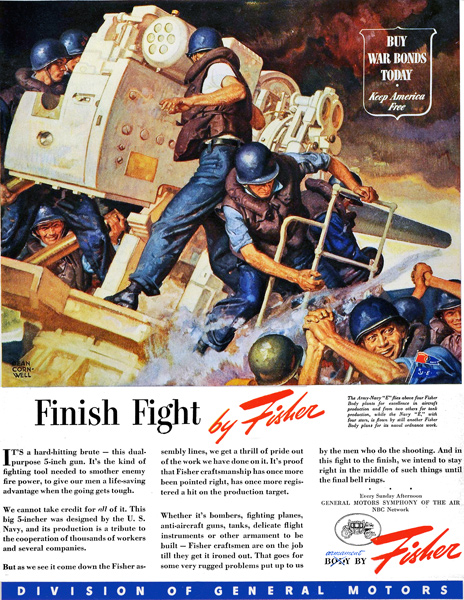Slick
Well-Known Member
This is from the blog "Woodpile Report".
Some interesting details and comparisons.
Let's talk guns. The ad below features the 5"/38, one of the all time greats. In the 1930s the surface-to-surface 5/51 and the anti-aircraft 5/25 were merged into the 5/38, "five-inch 38"—meaning a five inch bore with a barrel length of 38 calibers—one of those rare compromises that excelled in both roles. In enclosed single and twin mounts it became the standard gun on destroyers built from 1934 through the end of the war. Carriers sported fifty or more such mounts for anti-aircraft duty.
it became the standard gun on destroyers built from 1934 through the end of the war. Carriers sported fifty or more such mounts for anti-aircraft duty.
Open pedestal mounts as shown in the ad were more common on armed freighters, including the ubiquitous Liberty ships , mainly for duking it out with subs on the surface or dissuading them from approaching in trail. Nerdy details on this gun below the ad.
, mainly for duking it out with subs on the surface or dissuading them from approaching in trail. Nerdy details on this gun below the ad.

Some interesting details and comparisons.
Let's talk guns. The ad below features the 5"/38, one of the all time greats. In the 1930s the surface-to-surface 5/51 and the anti-aircraft 5/25 were merged into the 5/38, "five-inch 38"—meaning a five inch bore with a barrel length of 38 calibers—one of those rare compromises that excelled in both roles. In enclosed single and twin mounts
 it became the standard gun on destroyers built from 1934 through the end of the war. Carriers sported fifty or more such mounts for anti-aircraft duty.
it became the standard gun on destroyers built from 1934 through the end of the war. Carriers sported fifty or more such mounts for anti-aircraft duty. Open pedestal mounts as shown in the ad were more common on armed freighters, including the ubiquitous Liberty ships
 , mainly for duking it out with subs on the surface or dissuading them from approaching in trail. Nerdy details on this gun below the ad.
, mainly for duking it out with subs on the surface or dissuading them from approaching in trail. Nerdy details on this gun below the ad. 
The 5/38 was available in right or left hand models, walnut or composite stock. Kidding. As said above, the barrel was 38 calibers long, or 190 inches, which is nearly sixteen feet. It weighed one ton even. One round was comprised of a 28 pound powder cartridge and a 54 pound projectile. A destroyer's magazine typically held 2000 projectiles.
The projectile contained 15.5 pounds of powder, left the barrel at 2,500 feet per second, which generated a force on the warhead of 14,000g and 12,360 rpm. It was the g-force that armed the fuse, natch. Each one put about 38 lbs of shrapnel in the air. The range was 18,000 yards surface-surface, or 37,200 feet in anti-aircraft use. A long reach skyward was comforting when Kamikaze Industries made a business call.
For comparison, the "German 88" (8.8cm Flak 36) launched a 20 lb projectile—less than half the 5/38's 54 lbs—to 26,200 feet, 11,000 feet lower than the 5/38. As a practical matter, 88 Flak guns were aimed nearly vertical and bombers of the day flew at 21,000 to 25,000 feet. Surface-to-surface range for the 88 was 16,250 yds vs. 18,000 yards for the 5/38. Muzzle velocity and rate of fire were about the same. In Navy-speak the 88 would be a 3.5/56.
The 5/38 had fifteen inches of recoil, which prepared the gun for loading the next round, a sort of semi-semi-automatic. A well trained crew, and they were all well trained, could keep up a twenty-two rounds per minute rate of fire for a time—imminent death focuses the mind—but the sustained rate was fifteen rounds per minute. Side note: in a firefight, everything inside a naval gun turret was soon coated with greasy soot, smelled like a smoldering dumpster fire, and in the Pacific was hotter 'n hot. Looked good in the newsreels though.
The projectile contained 15.5 pounds of powder, left the barrel at 2,500 feet per second, which generated a force on the warhead of 14,000g and 12,360 rpm. It was the g-force that armed the fuse, natch. Each one put about 38 lbs of shrapnel in the air. The range was 18,000 yards surface-surface, or 37,200 feet in anti-aircraft use. A long reach skyward was comforting when Kamikaze Industries made a business call.
For comparison, the "German 88" (8.8cm Flak 36) launched a 20 lb projectile—less than half the 5/38's 54 lbs—to 26,200 feet, 11,000 feet lower than the 5/38. As a practical matter, 88 Flak guns were aimed nearly vertical and bombers of the day flew at 21,000 to 25,000 feet. Surface-to-surface range for the 88 was 16,250 yds vs. 18,000 yards for the 5/38. Muzzle velocity and rate of fire were about the same. In Navy-speak the 88 would be a 3.5/56.
The 5/38 had fifteen inches of recoil, which prepared the gun for loading the next round, a sort of semi-semi-automatic. A well trained crew, and they were all well trained, could keep up a twenty-two rounds per minute rate of fire for a time—imminent death focuses the mind—but the sustained rate was fifteen rounds per minute. Side note: in a firefight, everything inside a naval gun turret was soon coated with greasy soot, smelled like a smoldering dumpster fire, and in the Pacific was hotter 'n hot. Looked good in the newsreels though.
